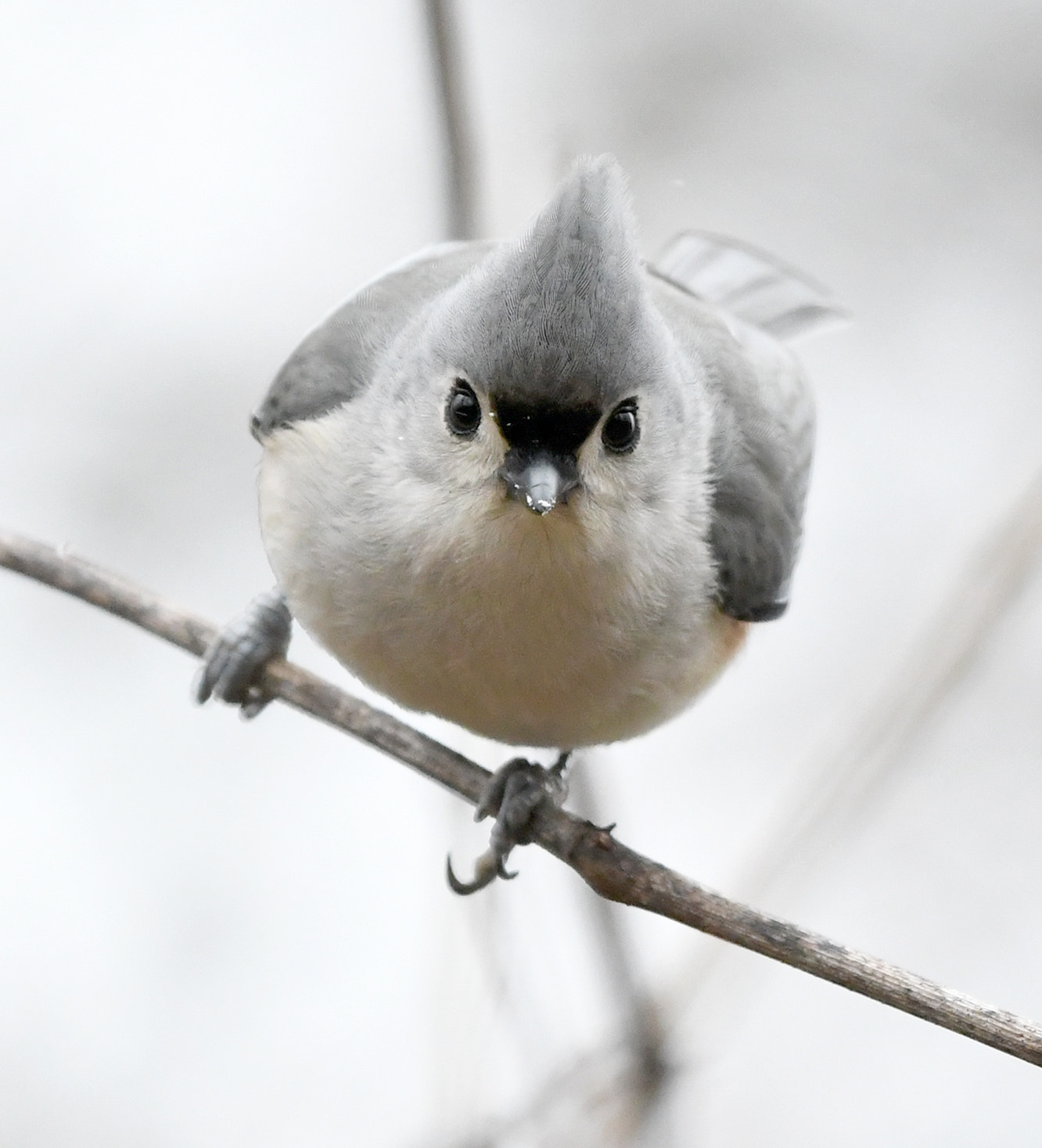Some 25 songbirds overwinter here on Owl Acres and surroundings. Sturdy little fellows that they are, they have figured out how to find food and survive in subzero temperatures. One food source that gets their attention is backyard bird feeders like the one we enjoy on Owl Acres. These little birds tend to flock together in the winter to find food and will be spending a lot of time at the bird feeder. Some will prefer the tiny seeds of the finch feeder, and others will opt for the larger ones such as the sunflower seeds. The suet blocks on the feeder will be particularly interesting to the insectivores like the downy woodpecker and the tufted titmouse.
The tufted titmouse gets its name from the old English “tit” meaning small, and “mase” meaning bird. Over time, “mase” turned to “mouse.” Now the question arises—what is the plural of titmouse? Titmice? Titmouses? Britannica says titmice, so that’s what we’ll use. The tufted part comes from the tufts of feathers on the bird’s head. These little birds use the tufts (or crests) to communicate. They can raise them up to signal aggression or dominance, and they can lay them back to signal submission.
Titmice don’t migrate, and their overall range is actually moving increasingly northward. At the beginning of the last century, Iowa was at the northern edge of their range. Today, they’re found as far north as Quebec and southern Ontario. This is most likely due to a combination of factors including milder winters, the restoration of farmland to forests in the Northeast, and the proliferation of backyard bird feeders. They can adapt to almost any place as long as there are mature trees.
These little birds are a soft silvery-gray on top and white beneath with rust-colored feathers on their flanks. They have a large head and big black eyes. The eyes are enhanced by a mascara-like ring of black feathers and a black patch just above the beak. They weigh less than an ounce and are about six inches long and seven to ten inches wingtip to wingtip.
During the breeding season, titmice pair off and maintain the pair bond throughout the year. The male will feed the female from the courtship period until after the eggs hatch. He will bring her choice morsels such as spiders, insects, seeds, and fruits. The female finds a nest cavity like the ones created by woodpeckers. She builds a cup-shaped nest made from twigs and grass and lined with soft grasses and hair. They have been known to swoop down and pluck the needed hair from the backs of living donors. The titmouse will lay a clutch of five or six eggs, incubate and hatch them while the male brings food for her and the nestlings. Young birds may stay with the parents through the winter and sometimes will help raise the brood the next year.
During the winter season, titmice will flock with other overwintering birds such as white-breasted nuthatches, kinglets, woodpeckers and chickadees. They prefer the sunflower seeds from the bird feeder. They crack the seeds open by holding a seed with their feet and pounding it open with their bills. They are also fond of the suet and can become aggressive toward interlopers when they’re feeding.
Absent a birdfeeder, titmice will forage for insects along tree branches, sometimes hanging upside down to probe the underside of a branch. During the fall and winter, they will stash seeds in tree bark and other hidey-holes against a hungry day.
The titmouse has a loud voice for its size. In spring they call “peter-peter-peter” to attract a mate and declare their territory. At other times of year they use their voices as alarm calls to alert the flock of danger.
To stay warm, like other small birds in winter, they conserve heat by keeping their bare legs just above freezing. They trap warm air by fluffing up their feathers, and they eat a lot to provide the energy they need to maintain their high body temperature (over 104 degrees Fahrenheit). They also shelter in cavities in trees out of the wind.
We’ll watch for these hardy little fellows on our suet and sunflower seeds, but Clancy may be startled next spring when one swoops down to snatch a hair or two off his back for her nest.
Photo from Wikimedia.org by: Jocelyn Anderson. Alt text: A small, grey song bird with a feathery crest sits on a twig, staring down a pretender. Tufted titmouse.
